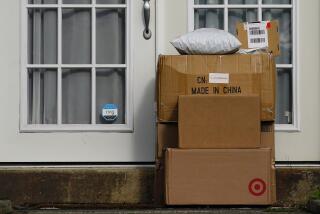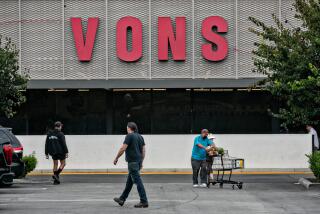E-Tailers Aiming for Many Happy Returns
- Share via
Last holiday season, online retailers were struggling to ship orders on time. Now they’re scrambling to avoid another potentially costly pitfall--product returns that can sap profits and alienate customers.
When the return season begins in earnest Dec. 26, unprepared online retailers risk being buried under a wave of unwanted Palms, ill-fitting sweaters and toys that didn’t play well with kids. Forrester Research estimates that online shoppers kicked back $600 million in goods last holiday season.
For the record:
12:00 a.m. Nov. 25, 2000 For the Record
Los Angeles Times Saturday November 25, 2000 Home Edition Business Part C Page 2 Financial Desk 1 inches; 27 words Type of Material: Correction
FedEx--A story in Thursday’s Business section incorrectly characterized the launch of FedEx Corp.’s return system for online retailers. FedEx’s NetReturn program has operated since 1997.
“This holiday season is going to be very telling for some retailers,” said Mark Hilinski, vice president of Irvine-based Return Exchange, a 2-year-old company that hopes to turn a profit by helping online retailers manage returns. “Accepting returns back has never been a profitable proposition.”
Yet returns are big business. Washington-based Cass Logistics estimates that U.S. businesses spent $921 billion in 1999--or nearly 10% of the gross national product--to ship goods. Of that total, businesses spent $37 billion to handle returned goods, said Ronald S. Tibben-Lembke, a logistics professor at the University of Nevada at Reno.
“The size, scope and impact of reverse logistics vary by industry,” Tibben-Lembke said. “But it is clear that the overall amount of reverse logistics in the economy is large and growing.”
One indicator that online companies are starting to pay attention to product returns is the rush of online entities with “return” in their names--Return.com, ReturnExchange.com, ReturnCentral.com and Ireturnit.com, to name a few. Real-world distribution powerhouses, including the U.S. Postal Service, Federal Express and Genco Distribution System, also are unveiling return systems designed for online retailers.
Joint ventures abound. Mail Boxes Etc. is aligned with Return.com, and trucking firm USFreightways Corp. has teamed with R.R. Donnelly Logistics Services, one of the nation’s largest commercial mailers. Electron Economy, a Cupertino, Calif.-based company that helps online companies manage their businesses, has teamed with Genco Distribution System, a Pittsburgh-based company that processes $6 billion in returns annually for Sears, Roebuck & Co. and other big retailers.
Some online retailers, including Amazon.com and Buy.com, are investing in sophisticated systems that strive to make returns as painless as online purchases.
Bad Return Systems Eat Into Profits
The best systems are designed to let consumers complete a return without ever having to talk to the online retailer. Using their personal computers, consumers can initiate a return, print out a return mailing label and track the return’s progress online. The system also should alert consumers that their accounts have been credited once the process is complete.
But experts say cash-strapped companies that are struggling to build brand awareness and sell goods often lack the funds needed to create such return systems.
Poorly designed return systems chew up potential profits. A rule of thumb in the bricks-and-mortar world is that “every 5% decrease in the cost of handling returns is equal to a 30% increase in sales,” said Genco Senior Vice President Pete Rector.
Estimates vary on how many online shipments are being returned. Boston Consulting Group reports that the 6% online return rate during the 1999 holiday season compares favorably with the bricks-and-mortar world. Boston-based AMR Research suggests that about 10% to 15% of Internet shipments are sent back.
Return rates vary depending upon the category. Books and CDs, for example, typically enjoy a relatively low return rate because customers generally know exactly what they want. But, in certain apparel and shoe categories, real-world return rates often soar to as high as 40%.
Online return rates are expected to swell as retail activity grows, more types of products are sold online and retailers greet the growing army of Internet newbies.
What’s more, some online retailers may have been lulled into a false sense of security because “early online adopters were willing to put up with glitches,” said James Vogtle, e-commerce research director for Boston Consulting Group. “But for any retail system to work in the mass market, it has to be foolproof, bulletproof.”
Market research now being conducted confirms that online shoppers are demanding better service. “Last year, shoppers were worried about product availability: ‘Do you really have that item in stock and will you get it here on time?’ ” said Chris Newton, senior analyst with AMR Research. “Now they’re checking return policies before they start shopping online. People want to know all the details up front, before they hit the ‘buy’ button.”
There’s growing evidence that “dot-coms” with bricks-and-mortar locations will enjoy a leg up over pure online ventures. “It’s simpler, in many cases, to return the goods to a physical storefront,” Vogtle said.
Online Shoppers Are More Demanding
But some consumers might be unpleasantly surprised when they try to return goods. Toysrus.com customers will have their purchases filled by the toy store chain’s online partner, Amazon.com. Toys purchased online, however, can’t be returned to Toys R Us bricks-and-mortar stores.
Returns can be a hassle for consumers and retailers whether they’re conducted online or off.
Consumers who’ve driven to a shopping mall, fought for a parking space and waited in the inevitable cash register line want immediate satisfaction in the form of exchanges or store credits. But consumers who’ve been fed a steady diet of dot-com commercials boasting about hassle-free online shopping probably will be even more demanding.
“Consumers already have this perception that, online, things are going to happen really quickly,” said Elaine Rubin, chairwoman of Shop.org, a Silver Spring, Md.-based trade organization that represents 400 online merchants. “It’s almost as if you place your order and run to the door to see if the UPS truck is there yet.”
Most shoppers are programmed to “believe the returns experience is going to be an ugly one,” said Thomas Wright, vice president of operations at Aliso Viejo-based Buy.com, which is using a high-tech return program designed by United Parcel Service.
“If we don’t handle the return process as good or better as the front end, then we’ve missed a big opportunity to build customer trust.”
Fumbled return exchanges can stress already fragile consumer loyalties.
“In their eyes, you’ve already failed them,” Tibben-Lembke said. “The Web site has spent all those dollars trying to get these customers, and now they’re not happy at all.”
Online shoppers who can’t get immediate satisfaction could grow resentful because “their credit card was charged within six nanoseconds of making the purchase,” Rector said. “And, if you tell them they’re going to have to wait through a billing cycle or two to see a credit, it’s not going to play well in Des Moines or anywhere else.”
Customer goodwill isn’t the only victim. Forrester Research reports that online retailers “wrote off millions of dollars” to process holiday returns in 1999. Yet, International Data Corp. notes that less than a quarter of online retailers are satisfied with their return processes.
The Buy.com online return system designed by UPS is tied directly to the retailer’s sales software system.
When Todd Heft wanted to return a video card he purchased at Buy.com, the 22-year-old Meriden, Conn., resident managed the transaction from his home computer. Buy.com’s online return system allowed him to print a mailing label on his home printer. He dropped the package at a nearby mailing center and, within days, received an e-mail advising him that the transaction was completed.
Customer Satisfaction Is the Ultimate Goal
“It was much easier than returning computer hardware to a store,” Heft said. “The only time I spent waiting was for the package to go across [the] country to the returns center. The whole thing went extremely fast.”
UPS’ system does more than keep customers happy.
“All of the information on that label is immediately available to the retailer, the distributor, the manufacturer, whoever needs to know,” said UPS spokesman Steve Holmes. “And when the box gets to where it’s going, the bar code can be scanned at the loading dock--you don’t have to open it to see what’s inside.”
“Keeping the customer happy is just part of it,” Tibben-Lembke said. “The other half is figuring out what to do with the stuff when it comes back. It’s all about managing the returns process more efficiently.”
(BEGIN TEXT OF INFOBOX / INFOGRAPHIC)
Whither Returns?
Forty-five apparel manufacturers and 65 consumer electronics manufacturers responded to surveys in mid-1999 about what they do with returned products.
Apparel Items
Resell to second markets: 38%
Throw away: 29%
Restock and reshelve: 24%
Donate: 9%
Consumer Electronic Items
Recycle: 34%
Remanufacture, resell to second markets: 26%
Throw away: 18%
Sell to second markets: 8%
Break down for parts: 5%
Other: 4%
Return to stock: 3%
Donate: 2%
*
Source: Reverse Logistics Executive Council
More to Read
Inside the business of entertainment
The Wide Shot brings you news, analysis and insights on everything from streaming wars to production — and what it all means for the future.
You may occasionally receive promotional content from the Los Angeles Times.










